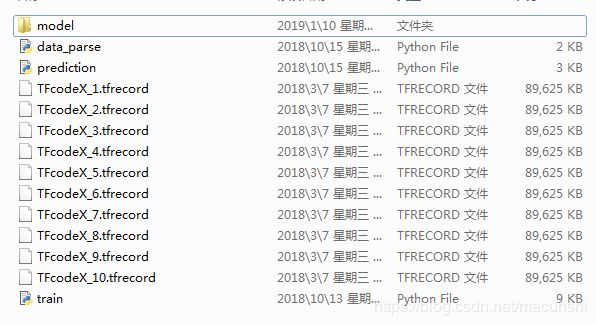Inception 迁移学习进行图像分类(保存pb模型+Tensorboard监视+matplotlib绘图监视)
这个使用Inception进行迁移学习来分类的代码网上有好多,我跑通了然后做了点修改,还增加了点东西。具备了pb模型保存的功能,添加了Tensorboard监视代码,还有使用matplotlib画准确率进行面板监视。
代码是python3下的。运行此代码之前先运行data_parse.py ,代码和需要的原始训练数据在这里。
Inception模型去这里下载:https://pan.baidu.com/s/1ilH1myOxbGT6nowBcnwT0Q
文件目录如下图所示:
model用于存放Inception模型和自己训练后保存的pb模型,data_parse.py用于解析tfrecord数据,train.py用于训练模型,prediction.py用于使用训练好的模型预测新的tfrecord数据,另外十个文件是原始数据。运行data_parse.py后会生成一个存放图片数据的flower_data文件夹,运行train.py后会生成Tensorboard用的logs文件夹,还有存放图片转化的输入向量的tmp文件。
如果自己动手做的话就按照上面一步步来,想省事的话我这里送上整个工程的文件压缩包:
https://download.csdn.net/download/macunshi/10914205
还有:
tensorboard的使用看这里:https://blog.csdn.net/macunshi/article/details/86234248
读取pb文件进行预测看这里:https://blog.csdn.net/macunshi/article/details/86232715
train.py代码在下面:
# -*- coding: utf-8 -*-
# train.py
# 运行此训练程序之前请先运行data_parse.py,博文中有链接
# Tensorflow:1.10.0
import operator
import glob
import re
import os.path
import random
import numpy as np
import tensorflow as tf
import matplotlib.pyplot as plt
from tensorflow.python.platform import gfile
from tensorflow.python.framework import graph_util
# 验证的数据百分比
VALIDATION_PERCENTAGE = 10
# 图片数据的文件夹
INPUT_DATA = 'flower_data/'
TEST_DATA = 'test_data/'
# 下载的谷歌训练好的inception-v3模型文件目录
MODEL_DIR = 'model/'
# 下载的谷歌训练好的inception-v3模型文件名
MODEL_FILE = 'tensorflow_inception_graph.pb'
BOTTLENECK_TENSOR_NAME = 'pool_3/_reshape:0'
# 图像输入张量所对应的名称
JPEG_DATA_TENSOR_NAME = 'DecodeJpeg/contents:0'
# inception-v3 模型瓶颈层的节点个数
BOTTLENECK_TENSOR_SIZE = 2048
# 保存训练数据通过瓶颈层后提取的特征向量
CACHE_DIR = 'tmp/bottleneck'
# 定义神经网路的设置
LEARNING_RATE = 0.01
STEPS =100000
BATCH =200
# 这个函数把数据集分成训练,验证两部分
def create_image_lists(validation_percentage):
result = {}
# 获取目录下所有子目录
sub_dirs = [x[0] for x in os.walk(INPUT_DATA)]
# 数组中的第一个目录是当前目录,这里设置标记,不予处理
is_root_dir = True
for sub_dir in sub_dirs: # 遍历目录数组,每次处理一种
if is_root_dir:
is_root_dir = False
continue
# 获取当前目录下所有的有效图片文件
extensions = ['jpg', 'jepg', 'JPG', 'JPEG']
file_list = []
dir_name = os.path.basename(sub_dir) # 返回路径名路径的基本名称,如:daisy|dandelion|roses|sunflowers|tulips
for extension in extensions:
file_glob = os.path.join(INPUT_DATA, dir_name, '*.' + extension) # 将多个路径组合后返回
file_list.extend(glob.glob(file_glob)) # glob.glob返回所有匹配的文件路径列表,extend往列表中追加另一个列表
if not file_list: continue
# 通过目录名获取类别名称
label_name = dir_name.lower() # 返回其小写
# 初始化当前类别的训练数据集、测试数据集、验证数据集
training_images = []
testing_images = []
validation_images = []
for file_name in file_list: # 遍历此类图片的每张图片的路径
base_name = os.path.basename(file_name) # 路径的基本名称也就是图片的名称,如:102841525_bd6628ae3c.jpg
# 随机讲数据分到训练数据集、测试集和验证集
chance = np.random.randint(100)
if chance < validation_percentage:
validation_images.append(base_name)
else:
training_images.append(base_name)
result[label_name] = {
'dir': dir_name,
'training': training_images,
'validation': validation_images
}
return result
# 这个函数通过类别名称、所属数据集和图片编号获取一张图片的地址
def get_image_path(image_lists, image_dir, label_name, index, category):
# 获取给定类别的图片集合
label_lists = image_lists[label_name]
# 获取这种类别的图片中,特定的数据集(base_name的一维数组)
category_list = label_lists[category]
mod_index = index % len(category_list) # 图片的编号%此数据集中图片数量
# 获取图片文件名
base_name = category_list[mod_index]
sub_dir = label_lists['dir']
# 拼接地址
full_path = os.path.join(image_dir, sub_dir, base_name)
return full_path
# 图片的特征向量的文件地址
def get_bottleneck_path(image_lists, label_name, index, category):
return get_image_path(image_lists, CACHE_DIR, label_name, index, category) + '.txt' # CACHE_DIR 特征向量的根地址
# 计算特征向量
def run_bottleneck_on_image(sess, image_data, image_data_tensor, bottleneck_tensor):
bottleneck_values = sess.run(bottleneck_tensor, {image_data_tensor: image_data})
bottleneck_values = np.squeeze(bottleneck_values)
return bottleneck_values
# 获取一张图片对应的特征向量的路径
def get_or_create_bottleneck(sess, image_lists, label_name, index, category, jpeg_data_tensor, bottleneck_tensor):
label_lists = image_lists[label_name]
sub_dir = label_lists['dir']
sub_dir_path = os.path.join(CACHE_DIR, sub_dir) # 到类别的文件夹
if not os.path.exists(sub_dir_path): os.makedirs(sub_dir_path)
bottleneck_path = get_bottleneck_path(image_lists, label_name, index, category) # 获取图片特征向量的路径
if not os.path.exists(bottleneck_path):
image_path = get_image_path(image_lists, INPUT_DATA, label_name, index, category)
# 获取图片原始路径
#image_path = get_image_path(image_lists, INPUT_DATA, label_name, index, category)
# 获取图片内容
image_data = gfile.FastGFile(image_path, 'rb').read()
# 计算图片特征向量
bottleneck_values = run_bottleneck_on_image(sess, image_data, jpeg_data_tensor, bottleneck_tensor)
# 将特征向量存储到文件
bottleneck_string = ','.join(str(x) for x in bottleneck_values)
with open(bottleneck_path, 'w') as bottleneck_file:
bottleneck_file.write(bottleneck_string)
else:
# 读取保存的特征向量文件
with open(bottleneck_path, 'r') as bottleneck_file:
bottleneck_string = bottleneck_file.read()
# 字符串转float数组
bottleneck_values = [float(x) for x in bottleneck_string.split(',')]
return bottleneck_values
# 随机获取一个batch的图片作为训练数据(特征向量,类别)
def get_random_cached_bottlenecks(sess, n_classes, image_lists, how_many, category, jpeg_data_tensor,
bottleneck_tensor):
bottlenecks = []
ground_truths = []
for _ in range(how_many):
# 随机一个类别和图片编号加入当前的训练数据
label_index = random.randrange(n_classes)
label_name = list(image_lists.keys())[label_index] # 随机图片的类别名
image_index = random.randrange(65536) # 随机图片的编号
bottleneck = get_or_create_bottleneck(sess, image_lists, label_name, image_index, category, jpeg_data_tensor,
bottleneck_tensor) # 计算此图片的特征向量
ground_truth = np.zeros(n_classes, dtype=np.float32)
ground_truth[label_index] = 1.0
bottlenecks.append(bottleneck)
ground_truths.append(ground_truth)
return bottlenecks, ground_truths
def create_inception_graph():
with tf.Graph().as_default() as graph:
model_filename = os.path.join(
MODEL_DIR, MODEL_FILE)
with gfile.FastGFile(model_filename, 'rb') as f:
graph_def = tf.GraphDef()
graph_def.ParseFromString(f.read())
bottleneck_tensor, jpeg_data_tensor = tf.import_graph_def(graph_def, name='', return_elements=[
BOTTLENECK_TENSOR_NAME, JPEG_DATA_TENSOR_NAME])
return graph, bottleneck_tensor, jpeg_data_tensor
def add_final_training_ops(class_count, bottleneck_tensor):
# 输入
bottleneck_input = tf.placeholder_with_default(bottleneck_tensor, [None, BOTTLENECK_TENSOR_SIZE], name='BottleneckInputPlaceholder')
ground_truth_input = tf.placeholder(tf.float32, [None, class_count], name='GroundTruthInput')
# 全连接层
with tf.name_scope('output'):
weights = tf.Variable(tf.truncated_normal([BOTTLENECK_TENSOR_SIZE, class_count], stddev=0.001))
biases = tf.Variable(tf.zeros([class_count]))
logits = tf.matmul(bottleneck_input, weights) + biases
final_tensor = tf.nn.softmax(logits, name='prob')
# 损失
cross_entropy = tf.nn.softmax_cross_entropy_with_logits_v2(logits=logits, labels=ground_truth_input)
cross_entropy_mean = tf.reduce_mean(cross_entropy)
tf.summary.scalar('loss', cross_entropy_mean)
train_step = tf.train.GradientDescentOptimizer(LEARNING_RATE).minimize(cross_entropy_mean)
# 正确率
with tf.name_scope('evaluation'):
out_label=tf.argmax(final_tensor, 1,name='out_prob')
correct_prediction = tf.equal(tf.argmax(final_tensor, 1), tf.argmax(ground_truth_input, 1))
evaluation_step = tf.reduce_mean(tf.cast(correct_prediction, tf.float32))
return (train_step,evaluation_step, cross_entropy_mean, bottleneck_input, ground_truth_input)
def main():
image_lists = create_image_lists( VALIDATION_PERCENTAGE)
n_classes = len(image_lists.keys())
graph, bottleneck_tensor, jpeg_data_tensor=create_inception_graph()
with tf.Session(graph=graph) as sess:
train_step,evaluation_step,cross_entropy_mean,bottleneck_input,ground_truth_input=add_final_training_ops(n_classes,bottleneck_tensor)
# 初始化参数
init = tf.global_variables_initializer()
sess.run(init)
#保存tensorboard所需数据在logs文件夹下
merged =tf.summary.merge_all()
writer = tf.summary.FileWriter('logs', sess.graph)
fig=plt.figure()#先生成一个画框
ax=fig.add_subplot(1,1,1)#总共一行一列,选第一个画图
#ax.scatter(x_data,y_data)#用点的形式将真实数据plot出
# 训练过程
x_label=[]
y_label=[]
for i in range(STEPS):
# 每次获取一个batch的训练数据
train_bottlenecks, train_ground_truth = get_random_cached_bottlenecks(sess, n_classes, image_lists, BATCH,
'training', jpeg_data_tensor,
bottleneck_tensor)
# 训练
sess.run(train_step,
feed_dict={bottleneck_input: train_bottlenecks, ground_truth_input: train_ground_truth})
# 验证
if i % 10 ==0 or i + 1 == STEPS:
validation_bottlenecks, validation_ground_truth = get_random_cached_bottlenecks(
sess, n_classes, image_lists, BATCH, 'validation', jpeg_data_tensor, bottleneck_tensor)
DRAW,validation_accuracy = sess.run([merged,evaluation_step], feed_dict={
bottleneck_input:validation_bottlenecks, ground_truth_input: validation_ground_truth})
print('Step %d: Validation accuracy on random sampled %d examples = %.1f%%' % (
i, BATCH, validation_accuracy * 100))
writer.add_summary(DRAW, i)
if i>0:
ax.lines.remove(lines[0])
x_label.append(i)
y_label.append(validation_accuracy*100)
lines=ax.plot(x_label,y_label)#用线画出预测值
plt.pause(0.01)
#if int(validation_accuracy*100)==100:
#break
#保存pb模型
constant_graph = graph_util.convert_variables_to_constants(sess, sess.graph_def, ["evaluation/out_prob"])
with tf.gfile.FastGFile("model/my_train.pb", mode='wb') as f:
f.write(constant_graph.SerializeToString())
main()
